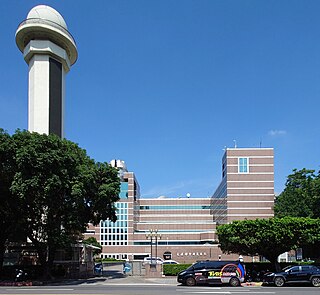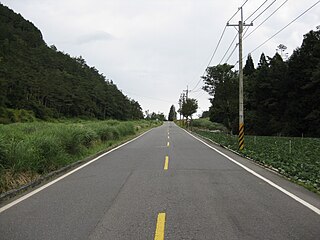| |||||
| Decades: | |||||
|---|---|---|---|---|---|
| See also: | Other events of 1946 History of Taiwan • Timeline • Years | ||||
Events in the year 1946 in Taiwan, Republic of China .
| |||||
| Decades: | |||||
|---|---|---|---|---|---|
| See also: | Other events of 1946 History of Taiwan • Timeline • Years | ||||
Events in the year 1946 in Taiwan, Republic of China .
| | This section is empty. You can help by adding to it. (June 2020) |

The Central Weather Administration is the government meteorological research and forecasting institution of the Republic of China (Taiwan). In addition to meteorology, the Central Weather Administration also makes astronomical observations, reports on sea conditions, and conducts research into seismology and provides earthquake reports. The Central Weather Administration is headquartered in Taipei City and is administered under the Ministry of Transportation and Communications.

The 2006 Hengchun earthquakes occurred on December 26 at 20:26 and 20:34 local time off the southwest coast of Taiwan in the Luzon Strait, which connects the South China Sea with the Philippine Sea. The International Seismological Centre measured the shocks at 7.0 and 6.9 on the moment magnitude scale. The earthquakes not only caused casualties and building damage, but several submarine communications cables were cut, disrupting telecommunication services in various parts of Asia.

Shanhua District is a suburban district of Tainan, Taiwan. Until 25 December 2010, it was an urban township in the dissolved Tainan County, which is now merged with the original Tainan City to form a single special municipality.
Republic of China on Taiwan is a political term as well as discourse regarding the present status of the Republic of China. It is proposed by former President of the Republic of China Lee Teng-hui, the first locally-born president. During his presidential tenure in 1995, Lee visited his alma mater Cornell University and mentioned this term for the first time when delivering an Olin Lecture.

The 1964 Baihe earthquake, also known as the Great Baihe earthquake, measured 6.3 local magnitude, and occurred at 20:04 CST (UTC+8) on 18 January in Baihe Township of Tainan County, Taiwan. The hypocenter of the earthquake was 20 kilometers deep. The earthquake killed 106 people, destroyed 10,924 buildings, and caused a great fire in Chiayi City. It was the sixth deadliest earthquake in 20th century Taiwan, and the third deadliest post-World War II, after the 1999 Jiji earthquake and the 2016 Taiwan earthquake.

The 1904 Douliu earthquake struck central Taiwan with a magnitude of 6.1 at 04:25 on November 6. The quake caused widespread damage and killed 145 people, making it the fifth deadliest earthquake of the 20th century in Taiwan.

The 1916–1917 Nantou earthquakes affected central Taiwan in 1916 and 1917, causing heavy damage in sparsely populated Nanto Chō and claiming 71 lives. The strongest quake registered at 6.8 ML and besides the loss of life caused widespread damage to agricultural and forestry industries in central Taiwan.

The 1935 Shinchiku-Taichū earthquake occurred with a Richter magnitude of 7.1 (7.0 Mw) in April 1935 with its epicenter in Taichung, Taiwan. It was the deadliest earthquake in Taiwan's recorded history, claiming 3,276 lives and causing extensive damage. Twelve seconds after the mainshock, an aftershock of ML 6.0 occurred, centered on Gabi Village.
The 1941 Chungpu earthquake occurred with a magnitude of 7.1 on December 17, and was centred on the town of Chūho Village, Kagi District, Tainan Prefecture of Taiwan under Japanese rule. It was the fourth-deadliest earthquake of the 20th century in Taiwan, claiming 358 lives.
The 1951 East Rift Valley earthquakes were a series of earthquakes which struck eastern Taiwan from 22 October 1951 to 5 December 1951, four of which registered at 7 or greater on the moment magnitude scale, the largest of those being magnitude 7.3 and 7.8 quakes on November 24. Altogether the quakes killed 85 people.

The 1959 Hengchun earthquake struck the southern tip of Taiwan on August 15. With a Richter magnitude of 7.1, it was the tenth deadliest earthquake in twentieth century Taiwan, killing 16 or 17 people.
The 1946 Hsinhua earthquake, also referred to as the 1946 Tainan earthquake was a magnitude 6.1 earthquake which hit Tainan County, Taiwan, on 5 December 1946, at 06:47. The quake claimed 74 lives and was the eighth deadliest earthquake in twentieth century Taiwan.

The 1972 Ruisui earthquake occurred on April 24 at 17:57 local time. The magnitude of this earthquake was given as Ms 7.2 by the United States Geological Survey and ML 6.9 by the Central Weather Bureau of Taiwan. The epicenter was located near Ruisui Township, Hualien County, Taiwan. The intensity was shindo 4 in Taipei and Hualien. Five people were reported dead. The Ruisui Bridge was destroyed. The water treatment plant in Ruisui was damaged.
The 1963 Su-ao earthquake occurred on February 13 at 16:50 local time. The epicenter was located off the coast of Taiwan, near Su-ao, Yilan County. It had a magnitude of Mw 7.3. The number of reported dead was 3–15 and the number of injured was 3–18.

Guguan Hot Spring is a hot spring located in Heping District, Taichung, Taiwan. It is accessible from Provincial Highway 8. It was previously named Meiji Onsen.
Han Taiwanese, Taiwanese Han, Taiwanese Han Chinese, or Han Chinese are Taiwanese people of full or partial ethnic Han descent. According to the Executive Yuan of Taiwan, they comprise 95 to 97 percent of the Taiwanese population, which also includes Austronesians and other non-Han people. Major waves of Han immigration occurred since the 17th century to the end of Chinese Civil War in 1949, with the exception of the Japanese colonial period (1895-1945). Han Taiwanese mainly speak three languages of Chinese: Mandarin, Hokkien and Hakka.

Siyuan Pass, formerly known as Piyanan Saddle (匹亞南鞍部), is a mountain pass in Datong Township, Yilan County, Taiwan. It is located along Provincial Highway 7A near the border of Taichung City.